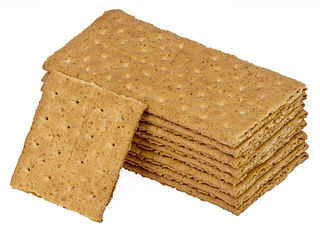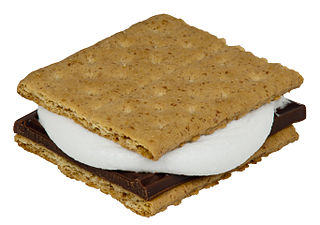
Marshmallow is a confectionery made from sugar, water and gelatin whipped to a solid-but-soft consistency. It is used as a filling in baking or molded into shapes and coated with corn starch. This sugar confection is inspired by a medicinal confection made from Althaea officinalis, the marsh-mallow plant.

A graham cracker is a sweet flavored cracker made with graham flour that originated in the United States in the mid-19th century, with commercial development from about 1880. It is eaten as a snack food, usually honey- or cinnamon-flavored, and is used as an ingredient in some foods, e.g., in the graham cracker crust for cheesecakes and pies.

Outdoor cooking is the preparation of food in the outdoors. A significant body of techniques and specialized equipment exists for it, traditionally associated with nomad in cultures such as the Berbers of North Africa, the Arab Bedouins, the Plains Indians, pioneers in North America, and indigenous tribes in South America. These methods have been refined in modern times for use during recreational outdoor pursuits, by campers and backpackers.

A s'more is a confection consisting of toasted marshmallow and chocolate sandwiched between two pieces of graham cracker. S'mores are popular in the United States and Canada, and are traditionally cooked over a campfire.
Banana is the common name for flowering plants of the genus Musa and for the fruit they produce.
Banana boat may refer to:

A pot pie or potpie is a type of savory pie, usually a meat pie, covered by a pie crust consisting of flaky pastry. Pot pies may be made with a variety of fillings including poultry, beef, seafood or plant-based meat substitute fillings, and may also differ in the types of crust.

"Day-O " is a traditional Jamaican folk song. The song has mento influences, but it is commonly classified as an example of the better known calypso music.
Happy Campers are a punk rock band, from Las Vegas.The band formed 1996 and went through several line up changes with the exception of singer/songwriter Isaac "Campa" Irvine. The band was a 3 piece for much of the 1990s and 2000s and toured heavily across the US. The music is heavily featured in several soundtracks including the Bumfights series, Insane Videos, Bam Margera and Tony Hawks Cribs Episodes to name a few. Music Videos for "Wave the Flags" and "Buried Alive" were directed by Travis Irvine and "Bleeding me Dry" by Isaac Irvine can as well as many live performances can be found on the bands YouTube channel at https://www.youtube.com/happycamperslv

Bánh lá, literally meaning "leaf cake", is a category of bánh, or Vietnamese cakes, that consist of a parcel of a variety of rice stuffed with some fillings and wrapped in a leaf or leaves.

Beggar's chicken is a Chinese dish of chicken that is stuffed, wrapped in clay and lotus leaves, and baked slowly using low heat. Preparation of a single portion may take up to six hours. Although the dish is traditionally prepared with clay, the recipe has evolved; for convenience and safety it is often baked with dough, oven bags, ceramic cooking pots, or convection ovens.

Arem-arem is an Indonesian-Javanese compressed rice cake in the form of a cylinder wrapped inside a banana leaf, filled with diced vegetables, tempeh, or oncom, and eaten as a snack. It is sometimes also filled with minced meat or abon. Arem-arem is often described as a smaller size lontong with fillings, so it is sometimes also called lontong isi.

Bánh tét is a Vietnamese savoury but sometimes sweetened cake made primarily from glutinous rice, which is rolled in a banana leaf into a thick, log-like cylindrical shape, with a mung bean and pork filling, then boiled. After cooking, the banana leaf is removed, and the cake is sliced into wheel-shaped servings.

Pisang cokelat or sometimes colloquially abbreviated as piscok, is an Indonesian sweet snack made of slices of banana with melted chocolate or chocolate syrup, wrapped inside thin crepe-like pastry skin and being deep fried. Pisang cokelat is often simply described as "choco banana spring rolls". It is often regarded as a hybrid between another Indonesian favourites; pisang goreng and lumpia.

Stuffed Puffs is an American confection company specializing in chocolate filled-marshmallows founded in 2012 and based in Bethlehem, Pennsylvania.













